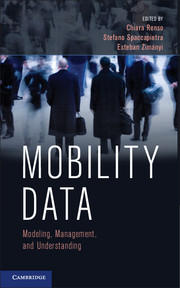Book contents
- Frontmatter
- Contents
- List of Contributors
- Preface
- Acknowledgments
- PART I MOBILITY DATA MODELING AND REPRESENTATION
- 1 Trajectories and Their Representations
- 2 Trajectory Collection and Reconstruction
- 3 Trajectory Databases
- 4 Trajectory Data Warehouses
- 5 Mobility and Uncertainty
- PART II MOBILITY DATA UNDERSTANDING
- PART III MOBILITY APPLICATIONS
- PART IV FUTURE CHALLENGES AND CONCLUSIONS
- Bibliography
- Glossary
- Author Index
- Subject Index
- Plate section
2 - Trajectory Collection and Reconstruction
from PART I - MOBILITY DATA MODELING AND REPRESENTATION
Published online by Cambridge University Press: 05 October 2013
- Frontmatter
- Contents
- List of Contributors
- Preface
- Acknowledgments
- PART I MOBILITY DATA MODELING AND REPRESENTATION
- 1 Trajectories and Their Representations
- 2 Trajectory Collection and Reconstruction
- 3 Trajectory Databases
- 4 Trajectory Data Warehouses
- 5 Mobility and Uncertainty
- PART II MOBILITY DATA UNDERSTANDING
- PART III MOBILITY APPLICATIONS
- PART IV FUTURE CHALLENGES AND CONCLUSIONS
- Bibliography
- Glossary
- Author Index
- Subject Index
- Plate section
Summary
Introduction
The research area of trajectory databases has addressed the need for representing movements of objects (i.e., trajectories) in databases in order to perform ad hoc querying and analysis on them. During the last decade, there has been a lot of research ranging from data models and query languages to implementation aspects, such as efficient indexing, query processing, and optimization techniques.
This chapter covers aspects related to data collection and handling so as to feed trajectory databases with appropriate data. We will also focus on the step trajectory reconstruction of the Geographic Privacy-aware KDD process (illustrated in Figure 2.1) emerged from the GeoPKDD project which proposed some solid theoretical foundations at an appropriate level of abstraction to deal with traces and trajectories of moving objects aiming at serving real world applications. This process consists of a set of techniques and methodologies that are applicable to mobility data and are organized in some well-defined and individual steps that have a clear target: to extract user-consumable forms of knowledge from large amounts of raw geographic data referenced in space and in time. However, when mobility data are about individuals, data collection is subject to privacy regulations and restrictions. To enable privacy-aware collection of position data, a complementary class of techniques is used, known as location PETs (privacy-enhancing technologies).
This KDD process can be applied to heterogeneous sources of mobility data.
- Type
- Chapter
- Information
- Mobility DataModeling, Management, and Understanding, pp. 23 - 41Publisher: Cambridge University PressPrint publication year: 2013
- 2
- Cited by



